人教版英语九年级全册Unit9 SectionB(3a-3b)优质课教案
人教版九全《Unit 9 Section B》教案
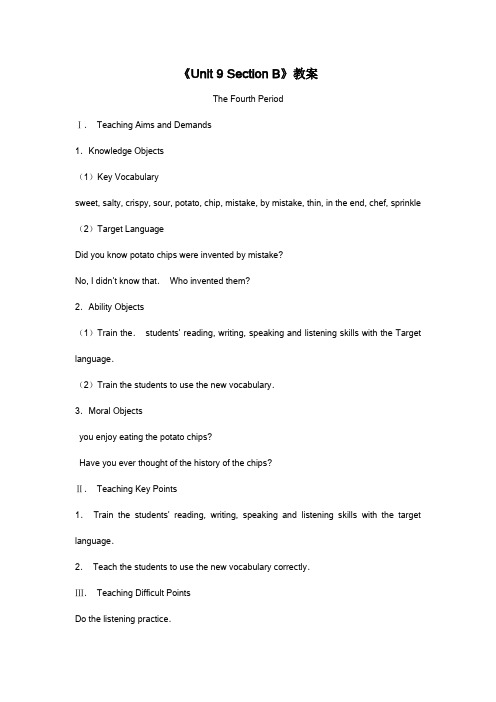
《Unit 9 Section B》教案The Fourth PeriodⅠ.Teaching Aims and Demands1.Knowledge Objects(1)Key Vocabularysweet, salty, crispy, sour, potato, chip, mistake, by mistake, thin, in the end, chef, sprinkle (2)Target LanguageDid you know potato chips were invented by mistake?No, I didn’t know that.Who invented them?2.Ability Objects(1)Train the.students’ reading, writing, speaking and listening skills with the Target language.(2)Train the students to use the new vocabulary.3.Moral Objectsyou enjoy eating the potato chips?Have you ever thought of the history of the chips?Ⅱ.Teaching Key Points1.Train the students’reading, writing, speaking and listening skills with the target language.2.Teach the students to use the new vocabulary correctly.Ⅲ.Teaching Difficult PointsDo the listening practice.Ⅳ.Teaching Methods1.Listening2.PairworkⅤ.Teaching Aids1.A tape recorder2.Some bags of potato chips.Ⅵ.Teaching ProceduresStep ⅠRevision1.Check the homework by asking some children to read their conversations to the class.2.Ask some questions about the inventions.For example, what do you think is the most helpful invention?3.Dictate the words below:bulb light, microwave oven, island.Step Ⅱ1aThis activity introduces new vocabulary.First, show the new vocabulary on the screen by a projector.Point to each word on the screen and teach the students to read one by one.Do it several times until the children can read the new words fluently.Read the instructions to the class.Point out the four adjectives on the left.Have them read the four words together.Then ask some different students to read them.Then ask the students to try to tell the meaning of each word in English in their own words, or give some examples of foods that show what each word means.For example, help the students explain it like this:Sweet is used for describing something that tastes like sugar or honey.It’s the opposite word of sour.After that, ask the Students to tell the names of the foods in the pictures potato chips, lemon, ice cream, tea.Please choose the words in the box to describe how the food in the pictures tastes.Write them under the correct pictures.Note that some pictures have more than one word.Tell them to see the example answer before writing.After a while, check the answers by asking several students to read their answers to the class.Answers:potato chips: crispy, saltylemon: sourice cream: sweettea: sweetOptional activityBring some foods that taste sweet, crispy, salty and sour to the class.Have some students, one at a time, taste little pieces of each food.Then report how the foods taste to the class with the new adjectives, sweet, crispy, salty and sour.Students may one more than one word to describe some foods.Step Ⅲ1bThis activity provides practice using the new vocabulary and writing familiar words.Ask the students to read the instructions together.Point out the four taste words.Then point to the sample answer given.Please write the name of a different food after each word.You can write the name of any food you know in the blank.Can you think of other sweet food now? (apple, orange, etc.)Ask the students to complete the activity on their own.After they all finish writing, ask some students to read their answers to the class.Check the answers with the whole class.Answers:Answers will vary but may include:sweet: apple, orange juice, soda, cake, honeycrispy: french fries, salad, lettucesalty: french fries, olives, pepperoni, pizza, popcornsour: pickle, grapefruitStep Ⅳ2aThis activity gives students practice understanding the target language in spoken conversation.Let the students read the instructions together.Be sure that they all know what to do.Call the students’ attention to the six sentences in the box.Ask six different students to read them and do some explanation in their own words on each sentence.After that, get the students to guess what they will hear about.Maybe someone can answer like this, may listen to something about the potato chips.Show some bags of potato chips them or even let some children taste the chips.Yes.You’ll hear a story about the invention of the potato chips.Please look at the first sentence now.It is a sample answer given.The statement is true so the letter T is circled.Then play the recording first.Students only listen.Play the recording again.Ask the children to listen and circle T for true or F for false.Check the answers with the whole class.1.T 2.F 3.T 4.F 5.F 6.TTapescriptBoy 1: Hey, did you know that potato chips were invented by mistake?Boy 2: Really? What do you mean?Boy 1: Well, here on the bag it says that they were invented by a chef called George Crum.Boy 2: When was that?Boy 1: Oh, it was way back in 1853.Boy 2: So, why was it an accident?Boy 1: Well, one day a customer in the restaurant where George worked sent back his plate of fried potatoes because he said they were cut too thick.Boy 2: So what happened?Boy 1: Well, George was in a bad mood, so he cut the potatoes really, really thin, and he cooked them for a long time until they were crispy.And he sprinkled lots of salt on them so they were really salty.He thought the customer would hate them.Boy 2: And?Boy 1: And the customer loved them and asked for more.He told the other customers about them, and soon everyone was ordering thinly-sliced, crispy, salty potato chips.Boy 2:And we’re still eating them today.What a cool story!Boy 1: Yeah.This activity gives students practice in understanding and writing the target language.Get the students to read the instructions together.Point to the blanks in the sentences in the story and tell them to complete the sentences while they are listening.You’ll listen to the same recording again.Before I play the recording, please try to give the answers by memory, or just by guessing.It doesn’t matter whether your answers are right or wrong.After a while, have the students get ready to listen.Play the recording again.Ask the students to fill in the blanks with the words they hear.Get several students to share their answers with the class.Correct the answers with the whole class.Answers1.Did you know 2.were invented3.1853 4.were crispy 5.really saltyStepⅥ2cThis activity provides guided oral practice using the target language.Play the recording of the history of chips again.Pause for the students to repeat after it.Get the students to read after the tape at least twice.Tell them to try their best to copy the pronunciation of the recording.Read the instructions to the class.Tell them that they will role-play the conversation, using the information from the activities in Activity 2a and Activity 2b.Ask a pair of the students to read the model conversation in the box.S A: Did you know potato chips were invented by mistake?S B: Wow, I didn’t know that.Who invented themS A: They were invented by a chef called George Crum.Write the conversation on the black board.Then ask another pair to make a conversation or continue the model conversation.They may say like this:A: Did you know potato chips were invented by mistake?B: Wow, I didn’t know that.Who invented them?A: They were invented by a chef called George Crum.B: Why was it an accident? Can you tell me the story?A: Well , one day a customer in the restaurant where George worked sent back his plate of fried potatoes because he said they were cut too thick.B: What happened next?A: So George was unhappy, he cut the potatoes really thin, and he cooked them for a long time until they were crispy.He sprinkled lots of salt on them so they were really salty.He thought the customers would hate them.B: Go ahead, please.A: And the customer loved them and asked for more.B: What a cool story!Step ⅦSummaryIn this class, we’ve learned to describe how food tastes with some new adjectives.And we’ve done much listening practice on the target language.At last, we did some oral practice by making our own conversations.Step ⅧHomework1.Try to remember the new words learned today.2.Write out the conversation that you made by yourselves in Activity 2c.StepⅨBlackboard Design。
人教版初中英语课标版 九年级第九单元Section B (3a — 3b) (共25张PPT)

A.I can sing along with it . B. it sounds smooth and cheer me up C. relaxed and beautiful D. sung E. popular music
Check your speaking
I took a concert of Chinese folk music last night. Erquan Yingyue that was played on the erhu moved me . I like it best. It was made by Abing . Abing played music that could touch the hearts of people . When we listen to his music, we can sense both the beauty and the sadness in it.
4.Why do you like this song ?
Reviewing
1.What’s your favorite kind of music ? 2.Why do you like it ? 3.What’s your favorite song ? 4.Why do you like this song ?
Unit 9
Section B Written practice
(3a — 3b)
Yichang summerlarge concert
人教版九年级英语全册教学设计:Unit9-sectionB
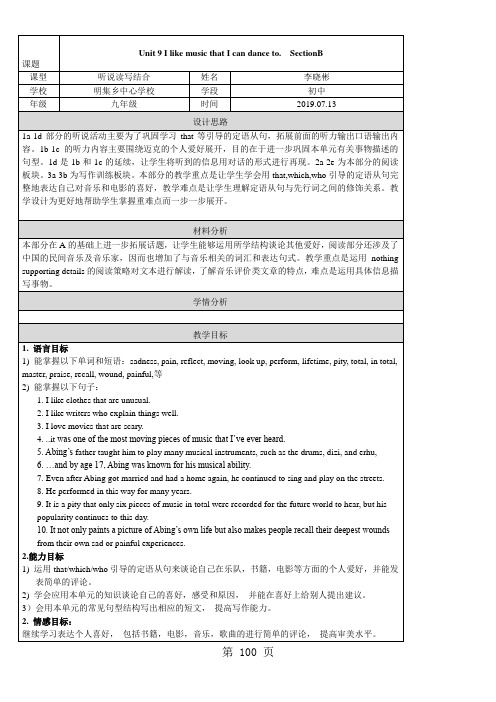
2)学会应用本单元的知识谈论自己的喜好,感受和原因,并能在喜好上给别人提出建议。
3)会用本单元的常见句型结构写出相应的短文,提高写作能力。
2.情感目标:
继续学习表达个人喜好,包括书籍,电影,音乐,歌曲的进行简单的评论,提高审美水平。
Step 4
完成教材2c-2e的任务
1.让学生再细读短文,在2c的表格中先用适当的单词完成各段落的主题思想,并在各段找出一个体现这个主体的细节填入表格中。
2.让学生阅读2d所给的短文。圈出who或that并在方框中选择恰当的词完成短文。并请1位同学朗读短文,全班集体核对答案。
3.让学生两人一组合作,一人为一名对阿丙感兴趣的外国游客,另一名为对阿丙有所了解的中国学生。参照2e方框中所给的对话提示编造对话,分角色练习。
学情分析
教学目标
1.语言目标
1)能掌握以下单词和短语:sadness, pain, reflect, moving, look up, perform, lifetime, pity, total, in total, master, praise, recall, wound, painful,等
教学资源
PPT, handouts, MP3, video
教学过程
教学环节
教师活动
学生活动
设计意图
Step 1
情景导入
回顾:在前面的课程我们已经学习并了解了一些音乐的信息和同学们喜爱的音乐种类。下面通过回答几个问题来进行一下简单的回顾。邀请几位同学尝试回答以下问题。(3分钟)
Questions:
1.Do you have your favorite band? What is it?
人教版英语九年级全册Unit9SectionA(3a3b)优秀教学案例

1. 引导学生对自己的学习过程进行反思,发现自身优点和不足,制定改进措施。
2. 教师对学生的学习成果进行评价,关注个体差异,给予积极、有针对性的反馈。
3. 运用形成性评价和终结性评价相结合的方式,对学生的语言知识、技能和情感态度进行全面评价。
4. 鼓励学生参与评价过程,提高他们的评价能力和自我认知能力。
四、教学内容与过程
(一)导入新课
1. 利用多媒体展示一系列环保问题,如空气污染、水污染、垃圾分类等,引导学生关注环保话题。
2. 向学生提问:“你们认为环保问题严重吗?为什么?”让学生发表自己的看法。
3. 引入本节课的主题:“保护环境”,并告诉学生本节课他们将学习如何用英语表达环保观点。
(二)讲授新知
在教学过程中,我充分运用任务型教学法、合作学习等教学策略,以学生为主体,关注个体差异,激发学生的学习兴趣和积极性。通过听力、口语、阅读和写作等多维度训练,帮助学生全面掌握本节课的核心词汇和句型,提高他们的英语综合运用能力。
在课程设计上,我注重将语言学习与现实生活紧密结合,让学生在实践中感知语言、运用语言。通过开展小组讨论、角色扮演等活动,引导学生关注环保问题,表达自己的观点和情感,培养他们的团队协作能力和创新思维。
5. 作业小结:本节课的作业布置具有针对性,要求学生运用所学知识写一篇关于环保的文章。这种作业形式既巩固了所学知识,又培养了学生的写作能力。同时,作业的完成情况也反映了学生对环保问题的关注程度,有助于教师了解学生的学习效果。
(二)过程与方法
1. 学生能够通过自主学习、合作学习等途径,掌握本节课所学的知识点,提高自学能力和团队协作能力。
2. 学生能够在真实的语言环境中运用所学知识进行交际,提高英语口语表达能力。
初中英语人教版九年级全册《Unit9 Section B Reading》教学设计
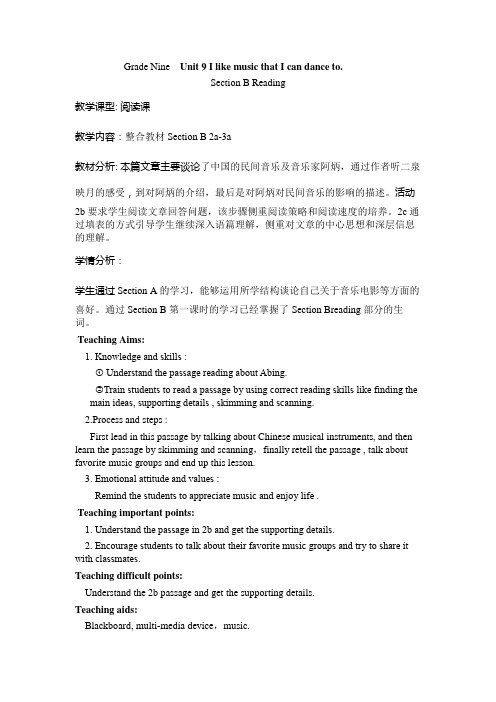
Grade Nine Unit 9 I like music that I can dance to.Section B Reading教学课型: 阅读课教学内容:整合教材Section B 2a-3a教材分析: 本篇文章主要谈论了中国的民间音乐及音乐家阿炳,通过作者听二泉映月的感受,到对阿炳的介绍,最后是对阿炳对民间音乐的影响的描述。
活动2b要求学生阅读文章回答问题,该步骤侧重阅读策略和阅读速度的培养。
2c通过填表的方式引导学生继续深入语篇理解,侧重对文章的中心思想和深层信息的理解。
学情分析:学生通过Section A 的学习,能够运用所学结构谈论自己关于音乐电影等方面的喜好。
通过Section B第一课时的学习已经掌握了Section Breading部分的生词。
Teaching Aims:1. Knowledge and skills :① Understand the passage reading about Abing.②Train students to read a passage by using correct reading skills like finding themain ideas, supporting details , skimming and scanning.2.Process and steps :First lead in this passage by talking about Chinese musical instruments, and then learn the passage by skimming and scanning,finally retell the passage , talk about favorite music groups and end up this lesson.3. Emotional attitude and values :Remind the students to appreciate music and enjoy life .Teaching important points:1. Understand the passage in 2b and get the supporting details.2. Encourage students to talk about their favorite music groups and try to share it with classmates.Teaching difficult points:Understand the 2b passage and get the supporting details.Teaching aids:Blackboard, multi-media device,music.Teaching procedures:Step1 Leading in ( Free talk)1. Teacher asks :“Do you like music ? Do you like Chinese folk music?”Step2 Pre-reading ( 2a )1.T : How many Chinese musical instruments do you know about ?Learn some Chinese musical instruments.2. Listen to Erquan Yingyue and answer.Q: What is the name of this piece of music ?Q: What is your feeling about this song ?Step3 While-reading1、Fast reading : Skimming (2b)Students read paragraph 1、2 and 3 quickly and try to answer some questions.Q1: What is the writer ' s feeling about this song ?Q2: Who wrote this song?Q3: What is the name of Abing's most famous piece of music?Q4: Which musician does the reading passage mainly talk about ?Learn the introduction of Abing.2、Careful reading: Scanning (2c)(1). Students read the article and use suitable words to complete the main idea of each paragraph. Then list the supporting details in each paragraph.(2). While reading, predict some important words.(3). Complete 2d. Fill in the blanks with the words in the box.Step4 Post-readingAccording to the small pictures and blanks retell the story about Abing .Step5 Group workTalk about students’ favorite music and then perform it.Teacher : Nothing is worth living for without music. -----NietzscheStep6 HomeworkWrite a short passage about your favorite music : Use the following expressions to help you :1、My favorite music is ......2、I like ......because......3、This song was sang by ....4、Do you know more about the singer ?。
人教版九年级英语全册教学设计:Unit9sectionB
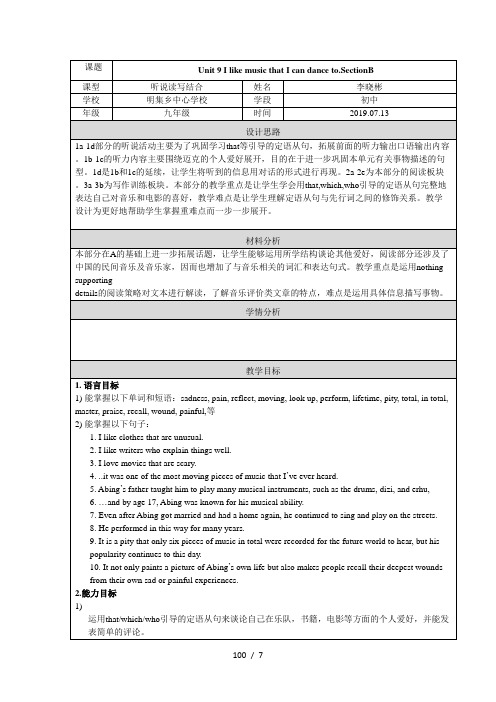
教学目标
1. 语言目标
1) 能掌握以下单词和短语:sadness, pain, reflect, moving, look up, perform, lifetime,pity, total, in total, master, praise, recall, wound, painful,等
2
Abing lived a very _____ life.
3
Abing’s musical skills made him very ______.
教学反思
背景材料的补充
Abing’s Life
Abing was born on August 17, 1893, in the eastern Chinese city of Wuxi to father Hua Qinghe, who was a priest. His mother was a widow, and her remarriage to a priest was resented by her family; she remained depressed and died a year after Abing's birth. Abing was raised by extended family until the age of eight, when he went to live with his father at the temple. Abing was the name used by his family. He was given the official name Hua Yanjun at this time and sent to school.
____________________________________
人教版英语九年级全册Unit9SectionB(1a1d)优秀教学案例

(四)反思与评价
1.学生自我反思:让学生回顾自己的学习过程,思考自己在学习一般过去时的被动语态方面的优点和不足,并提出改进措施。
2.同伴评价:鼓励学生互相评价,给出建设性的建议,共同提高。
3.教师评价:教师对学生的学习过程和成果进行评价,及时反馈,指导学生下一步的学习方向。
四、教学内容与过程
(一)导入新课
1.图片引入:展示一张过去事件的图片,如“last week’s football match”,引导学生思考如何用英语描述这张图片。
2.复习引入:回顾之前学过的一般过去时的主动语态,如“I visited my grandparents last weekend.”,提醒学生注意今天将要学习的一般过去时的被动语态。
3.语法练习:设计一些练习题,让学生分组讨论和完成,巩固所讲语法知识。
(三)学生小组讨论
1.小组活动:让学生分成小组,每组选择一个练习题,讨论如何用一般过去时的被动语态来完成这个练习。
2.小组互动:鼓励学生之间互相提问、解答,培养他们的合作能力和团队精神。
3.小组展示:各小组选代表展示自己的讨论成果,分享学习心得。
2.学生在学习过程中,能够树立自信心,克服困难,培养自己坚强的意志力。
3.学生能够尊重和理解不同文化,培养自己的跨文化交际意识。
4.学生能够认识到学习英语的重要性,提高自己的综合素质,为将来的学习和工作打下坚实的基础。
三、教学策略
(一)情景创设
1.生活情境:通过呈现生活中的一般过去时的被动语态的例子,如“The cake was baked by my mother yesterday.”,帮助学生理解和掌握语法知识。
人教版九年级英语全册Unit9SectionB(3a~SelfCheck)说课稿
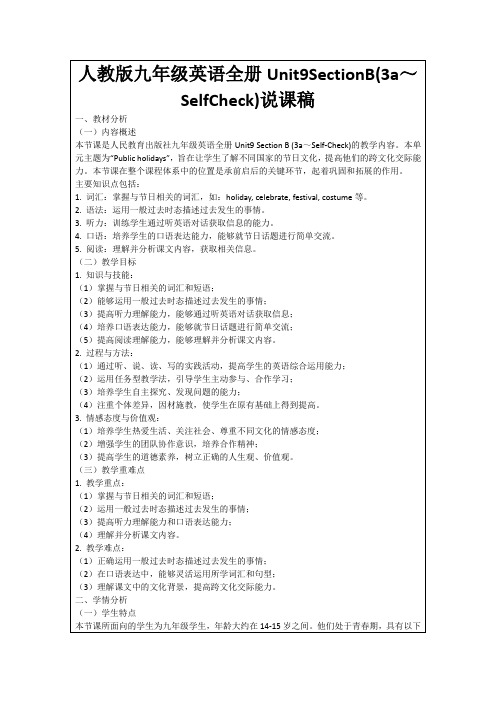
(一)学生特点
本节课所面向的学生为九年级学生,年龄大约在14-15岁之间。他们处于青春期,具有以下特点:首先,年龄特征上,他们活泼好动,好奇心强,对新鲜事物充满兴趣,但注意力容易分散;其次,认知水平上,经过两年的英语学习,他们已经具备了一定的英语基础,能够理解和使用基本的英语语法和词汇,但尚需提高英语综合运用能力;再次,学习兴趣上,他们对英语学习有一定兴趣,尤其是对与生活相关的英语话题较为感兴趣;最后,学习习惯上,他们已经形成了较为稳定的学习习惯,但部分学生可能存在学习方法不当、学习效率不高的问题。
四、教学过程设计
(一)导入新课
新课导入是激发学生学习兴趣和吸引注意力的关键环节。我将通过以下方式导入新课:首先,利用一段关于不同国家节日的短视频,让学生在视觉和听觉上感受节日的氛围;其次,邀请学生分享他们对节日的了解和经验,以此引发学生的兴趣和共鸣;最后,提出本节课的学习目标,让学生明确本节课的学习内容和要求。这样的导入方式可以迅速吸引学生的注意力,激发他们对新课内容的兴趣。
(二)教学反思
在教学过程中,可能遇到的问题是学生对新知识点的理解不够深入,或者在实际应用中遇到困难。为应对这些问题,我会及时调整教学策略,通过举例、重复讲解、个别辅导等方式帮助学生克服难点。课后,我会通过作业批改、学生反馈和课堂表现来评估教学效果。具体的反思和改进措施包括:针对学生的薄弱环节进行针对性的辅导,调整教学进度以适应学生的实际需要,以及通过反思日志记录教学过程中的亮点和不足,不断优化教学方法,提高教学质量。
(五)作业布置
课后作业的目的是巩固课堂所学知识,提高学生的自主学习能力和语言运用能力。我将布置以下作业:首先,要求学生复习本节课的核心词汇和语法点,并完成相关的练习题;其次,布置一篇小作文,让学生描述一个他们喜欢的节日,并在写作中使用本节课学到的语言知识;最后,鼓励学生观看英语学习视频或阅读英语文章,拓宽他们的视野,提高他们的英语水平。作业的布置旨在让学生在课后能够自主复习和练习,为下一节课的学习打下坚实的基础。
人教版英语九全Unit9SectionA(3a3b)教学设计

3.写作能力有待提高,对场景描述和情感表达方面存在困难。
4.部分学生对英语学习缺乏信心,课堂参与度不高,影响学习效果。
针对以上学情,教师在教学过程中应注重以下方面:
1.丰富学生的词汇量,通过图片、实物等直观教学手段,帮助学生理解和记忆时尚词汇。
6.写作指导:结合教材中的写作任务,指导学生进行场景描述和情感表达。在写作过程中,关注学生的语法、词汇运用,提高写作能力。
7.课堂互动:注重师生互动、生生互动,通过提问、讨论等方式,激发学生的思维,提高课堂参与度。
8.情感教育:在教学过程中,关注学生的情感需求,鼓励他们积极参与课堂活动,增强自信心。
1.写作练习:根据本节课学习的时尚秀话题,运用所学词汇和一般现在时态,写一篇关于自己理想中的时尚秀的短文。要求内容丰富,条理清晰,不少于80词。
2.口语作业:与同学合作,进行角色扮演,模拟一次时尚秀的场景。要求每位同学都要参与表演,尽量运用所学词汇和时态进行对话。
3.词汇复习:复习本节课学习的时尚词汇和短语,结合教材和笔记,进行自我测试,确保熟练掌握。
4.教师引导学生关注对话中的时态,总结一般现在时态的用法和结构,并通过实例进行讲解。
5.学生跟随教师一起练习对话中的重点句子,巩固一般现在时态的运用。
(三)学生小组讨论
1.将学生分成小组,每组选择一个时尚秀的场景,讨论并准备一段对话,描述该场景。
2.学生在小组内部分工合作,一人扮演设计师,一人扮演模特,一人扮演观众等角色,运用所学词汇和一般现在时态进行对话。
人教版英语九全Unit9SectionA(3a3b)教学设计
一、教学目标
(一)知识与技能
人教版九年级英语全册Unit9单元优秀教学案例
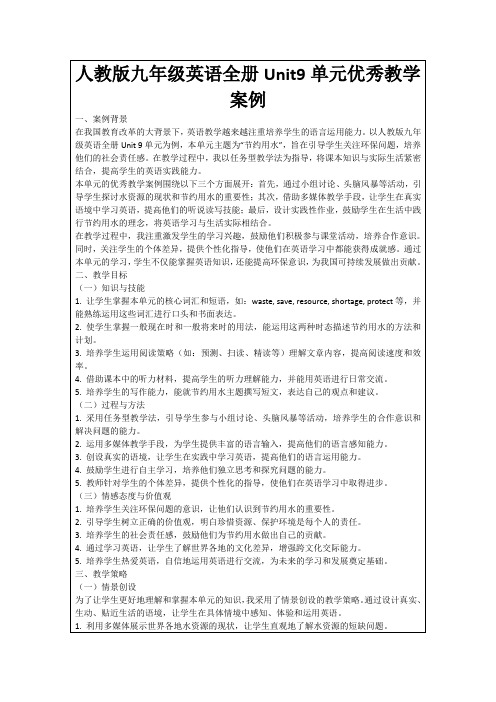
(五)作业小结
为了巩固所学知识,我设计了以下作业:
1.家庭作业:让学生结合所学,以“节约用水”为主题,写一篇英语短文,分享自己的观点和建议。
2.课后实践:鼓励学生在生活中践行节约用水,记录自己的行动,下节课与同学分享。
3.预习任务:布置下一节课的学习内容,让学生提前预习,为新课的学习做好准备。
4.教师在小组活动中关注学生的参与度,给予个性化的指导和建议。
(四)反思与评价
反思与评价是教学过程中的重要环节,有助于学生总结经验、发现不足,提高学习能力。
1.鼓励学生在课后进行自我反思,总结自己在课堂上的表现,找出自己的优点和不足。
2.教师对学生的学习过程和成果进行全面、客观的评价,关注学生的个体差异。
5.如何向身边的人宣传节约用水的重要性?
(三)小组合作
小组合作是本单元教学的重要策略,旨在培养学生的团队协作能力和沟通能力。
1.将学生分成若干小组,让他们围绕节约用水主题展开讨论,共同完成学习任务。
2.鼓励小组成员相互倾听、交流、分享,共同解决问题。
3.设计小组竞赛活动,激发学生的学习积极性,提高课堂氛围。
二、教学目标
(一)知与技能
1.让学生掌握本单元的核心词汇和短语,如:waste, save, resource, shortage, protect等,并能熟练运用这些词汇进行口头和书面表达。
2.使学生掌握一般现在时和一般将来时的用法,能运用这两种时态描述节约用水的方法和计划。
3.培养学生运用阅读策略(如:预测、扫读、精读等)理解文章内容,提高阅读速度和效率。
1.利用多媒体展示世界各地水资源的现状,让学生直观地了解水资源的短缺问题。
人教版九年级英语全册Unit9sectionB优秀教学案例
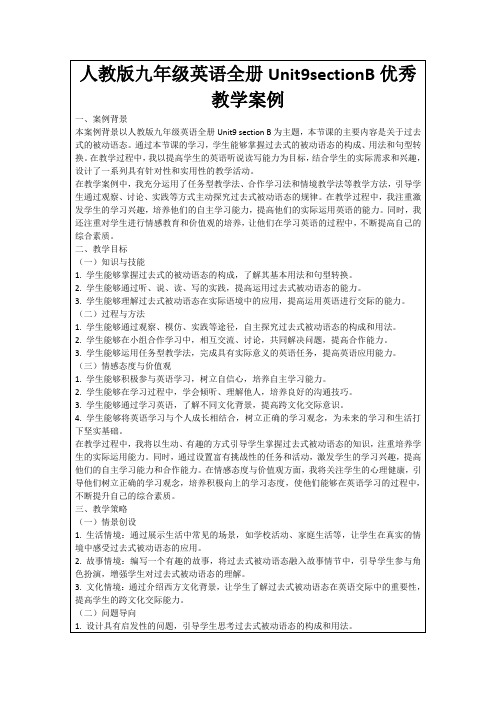
五、案例亮点
1.情景创设:本节课通过生动有趣的故事情境,使学生在真实的环境中感受过去式被动语态的应用,提高了学生的学习兴趣和积极性。
2.问题导向:本节课以问题为导向,引导学生自主探究过去式被动语态的构成和用法,培养了学生的思考能力和解决问题的能力。
(二)讲授新知
1.我将通过PPT展示过去式被动语态的构成和用法,用生动的图片和例句进行解释,让学生直观地理解这一语法知识。
2.在讲解过程中,我会邀请学生上台演示过去式被动语态的句子,增强学生的参与感和实践能力。
3.针对过去式被动语态的句型转换,我将给出一些练习题,引导学生进行课堂练习,巩固所学知识。
4.学生能够将英语学习与个人成长相结合,树立正确的学习观念,为未来的学习和生活打下坚实基础。
在教学过程中,我将以生动、有趣的方式引导学生掌握过去式被动语态的知识,注重培养学生的实际运用能力。同时,通过设置富有挑战性的任务和活动,激发学生的学习兴趣,提高他们的自主学习能力和合作能力。在情感态度与价值观方面,我将关注学生的心理健康,引导他们树立正确的学习观念,培养积极向上的学习态度,使他们能够在英语学习的过程中,不断提升自己的综合素质。
三、教学策略
(一)情景创设
1.生活情境:通过展示生活中常见的场景,如学校活动、家庭生活等,让学生在真实的情境中感受过去式被动语态的应用。
2.故事情境:编写一个有趣的故事,将过去式被动语态融入故事情节中,引导学生参与角色扮演,增强学生对过去式被动语态的理解。
3.文化情境:通过介绍西方文化背景,让学生了解过去式被动语态在英语交际中的重要性,提高学生的跨文化交际能力。
2.引导学生互相交流、讨论,培养学生的沟通技巧和合作精神。
九年级英语上册(人教版)课件:Unit 9 Section B (3a3b

⑥I like/prefer...that/which... 拓展常用句型: ①I dislike...because... ②I'm sure that展示一
不同的人喜欢不同的音乐。你喜欢或者不喜欢什么音乐呢?请你写一 篇短文谈谈你对不同音乐类型的好恶及其原因。
教材中出现的能用于此类作文的句型: ①My favorite kind of music/movie is... ②I like...because... ③It was...by... ④When I listen to/watch it,I feel... ⑤I think you should listen to/watch it too because...
要求:中心突出,观点明确;80词左右。 提示词:R&B music;noisy music Different people like different music.I like listening to music in my free time.①I like music that has great lyrics and I can sing along with.I prefer gentle and quiet music.Some R&B music is my favorite.②This kind of music often reminds me of someone who I care about and makes me feel happy or sad.③I dislike noisy music or songs with words that I can't understand.What kind of music do you like? 【点拨】开门见山,点明主题。用①②说明喜欢的理由,用③说明不 喜欢的理由。问句结尾使文章更生动,起到了画龙点睛的作用。
人教版英语9年级全册Unit9_SectionB(2a-Self_Check)教案

3a-3b部分是写作训练版块。
3a是一个写作前的思考准备,呈现了与音乐或电影相关的问题,要求学生填写信息,整理写作要点。
3b布置写作任务并且提供了相关的短语和表达,以便学生完成写作任务。
【通过本单元的学习学生需掌握哪些综合技能】
T:Now let’s enjoy a video to learn more about Chinese musical instruments.
1.通过free talk的形式复习表达喜好的句型。
2.通过图片展示乐器类型导入本课话题,吸引学生的注意力。
3. “听歌识曲”激发学生的学习兴趣,调动学生的学习热情。
3.培养学生的阅读能力和归纳能力。
4.复习that/who/which引导的定语从句的用法.
5.学会用that/who/which引导的定语从句描述自己的喜好,并能发表简单的评论。
6.学会应用本单元的知识谈论自己的喜好、感受和原因,并能在喜好上给别人提出建议。
7.会用本单元的常见句型结构写出相应的短文,提高学生的写作能力。
T:Do you know any Chinese musical instruments?
2.Show students some pictures of Chinese musical instruments and ask students to tell the names.
Brass & woodwind:dizi, xiao, suona, cucurbit flute
Then check the answers.
4.Get students find out the Attributive clauses in the passage and try to understand.
人教版初中九年级英语Unit9_SectionB(3a-3b)优质课教案
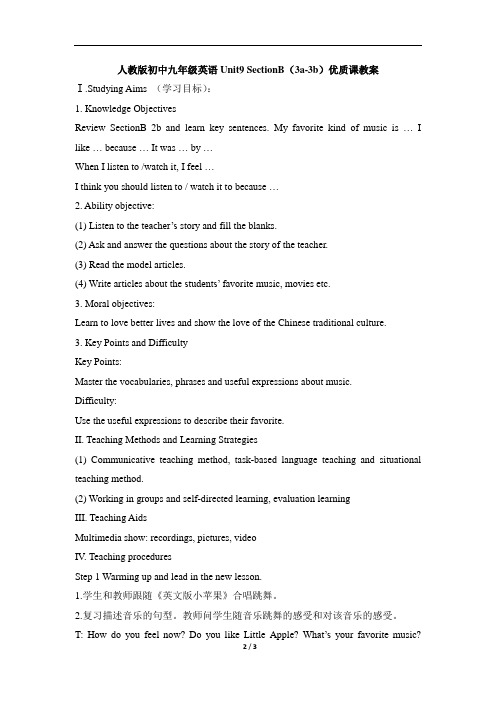
人教版初中九年级英语Unit9 SectionB(3a-3b)优质课教案Ⅰ.Studying Aims (学习目标):1. Knowledge ObjectivesReview SectionB 2b and learn key sentences. My favorite kind of music is (I)like … because … It was … by …When I listen to /watch it, I feel …I think you should listen to / watch it to because …2. Ability objective:(1) Listen to the teacher’s story and fill the blanks.(2) Ask and answer the questions about the story of the teacher.(3) Read the model articles.(4) Write articles about the students’ favorite music, movies etc.3. Moral objectives:Learn to love better lives and show the love of the Chinese traditional culture.3. Key Points and DifficultyKey Points:Master the vocabularies, phrases and useful expressions about music.Difficulty:Use the useful expressions to describe their favorite.II. Teaching Methods and Learning Strategies(1) Communicative teaching method, task-based language teaching and situational teaching method.(2) Working in groups and self-directed learning, evaluation learningIII. Teaching AidsMultimedia show: recordings, pictures, videoIV. Teaching proceduresStep 1 Warming up and lead in the new lesson.1.学生和教师跟随《英文版小苹果》合唱跳舞。
人教版英语九年级全一册Unit 9 SectionB 3a-self check教案

Difficulty
Train students’writing skill.
Teachingmethods
Target Teaching, Task-based Language Teaching,Communicative Teaching,Teaching by illumination and asking questions.
Why do you like this kind of music?
How do you feel when you listen to this kind
of music?in pairs.
1. Listen and think.
2. Talk in pairs.
Arousethe students’interest inwhat we wiቤተ መጻሕፍቲ ባይዱl learn in this class.
(1)Train the students’writing skills.
(2)Toreviewthe usages of attributive clauses in that/which/who
Importance
1. Key vocabulary.
2. Train students’writing skill.
Step 2
Show the learningaims.
Show thelearningaims to the students.
Look and read carefully.
Let the students know what they should do in this class.
人教版英语九年级全册Unit9SectionA(3a3b)教学设计

一、教学目标
(一)知识与技能
1.学生能够掌握并运用本节课的核心词汇和短语,如"pollution", "waste", "environmentally friendly", "reduce", "recycle"等,并能运用到日常生活对话中。
(二)讲授新知,500字
1.教师引导学生预习课文3a和3b,让学生尝试运用阅读策略了解文章大意。
2.教师讲解课文中的核心词汇和短语,如"pollution", "waste", "environmentally friendly", "reduce", "recycle"等,并举例说明其用法。
3.教师讲解一般现在时和一般过去时的被动语态,通过实例和练习,帮助学生掌握语法知识。
1.编写一篇关于环保的短文,内容可以包括以下几个方面:
-描述一个你身边的环保问题;
-分析这个问题产生的原因;
-提出至少三个解决该问题的方法;
-使用一般现在时和一般过去时的被动语态进行表达。
要求:不少于100词,语言准确、表达流畅。
2.设计一份环保宣传册,内容包括:
-环保标语:至少三条,要求简洁明了,具有感染力;
-环保小知识:介绍一个环保小窍门或环保习惯;
-环保行动:介绍一个你参与的环保活动或计划。
要求:图文并茂,美观大方,体现环保主题。
3.小组合作,录制一段关于环保的英语对话,内容可以是讨论环保问题或分享环保心得。要求如下:
-每位组员都要参与;
-使用一般现在时和一般过去时的被动语态;
人教版英语九全Unit9SectionA(3a3b)优秀教学案例
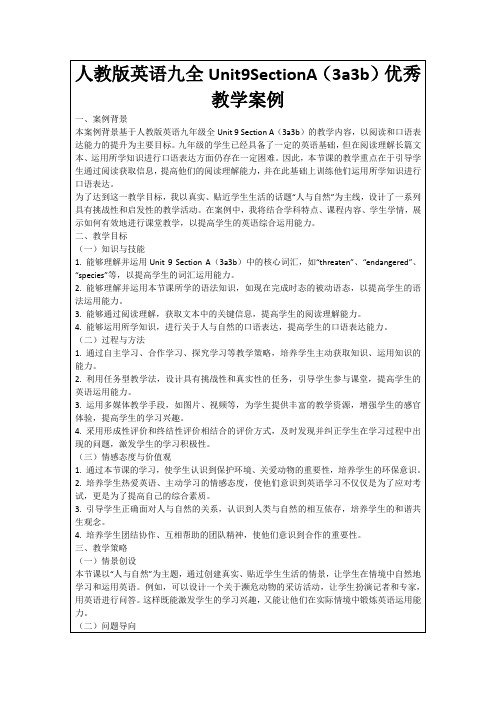
(四)总结归纳
在总结归纳环节,我会邀请几名学生分享他们小组讨论的结果。我会根据学生的回答,引导学生总结出保护濒危动物的重要性和方法。同时,我也会强调人与自然和谐共生的重要性,让学生明白保护环境是对自己和后代的责任。
(五)作业小结
在作业小结环节,我会布置一道相关的作业,让学生运用所学知识进行思考和表达。例如,可以要求学生撰写一篇短文,描述一种濒危动物,并提出保护它的建议。通过作业小结,巩固学生对本节课内容的理解和运用。
(二)问题导向
本节课采用问题导向的教学方法,引导学生主动思考、探究问题。在教学过程中,我可以提出一些问题,如“为什么某些动物濒临灭绝?”、“我们应该如何保护濒危动物?”等,让学生进行思考和讨论。通过问题导向,激发学生的思维能力,培养他们解决问题的能力。
(三)小组合作
本节课采用小组合作的学习方式,让学生在小组内进行讨论、探究、合作。例如,可以让学生分组进行一个关于濒危动物的保护计划设计,每个小组需要用英语撰写计划并进行展示。这样既能培养学生的团队合作精神,又能让他们在实际操作中运用所学知识。
4.培养学生团结协作、互相帮助的团队精神,使他们意识到合作的重要性。
三、教学策略
(一)情景创设
本节课以“人与自然”为主题,通过创建真实、贴近学生生活的情景,让学生在情境中自然地学习和运用英语。例如,可以设计一个关于濒危动物的采访活动,让学生扮演记者和专家,用英语进行问答。这样既能激发学生的学习兴趣,又能让他们在实际情境中锻炼英语运用能力。
新版人教版九年级英语第九单元SectionB导学案市公开课一等奖省优质课获奖课件
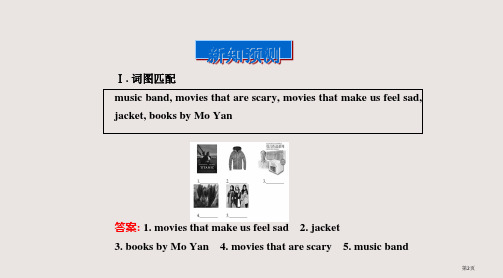
查阅, 指在词典等资料中查找, 代词作宾语时 look____
置于短语中间
look____ 寻找, 强调动作
find
找到, 强调找结果
find____ 查明, 强调经过一番努力后得出结果
答案: up; for; out
第21页
【学以致用】
(·成都中考)I have ______ my watch everywhere. But I cannot
第2页
Ⅱ. 句型填词 1. 他喜欢奇异衣服。 He likes clothes__________ __________ unusual. 2. 说说你喜欢每件事情原因。 Say__________ you__________ each thing. 答案: 1. that are 2. why; like
__________________
3. 伴随; 与……一起
along________
4. 比如
such________
答案: 1. 查阅 2. 总共 3. with 4. as
第15页
Ⅲ. 句型填词 1. 那首用二胡演奏乐曲尤其使我感动。 The piece__________ __________ played on the erhu especially moved me. 答案: which was 那首二胡曲听起来就像有些人在哭泣, 我听时候几乎随之哭起来。 The erhu__________ __________ someone__________ , and I almost cried__________ __________ it as I listened. 答案: sounded like; crying; along with
人教版九年级英语全册Unit9SectionB(3a~SelfCheck)优秀教学案例
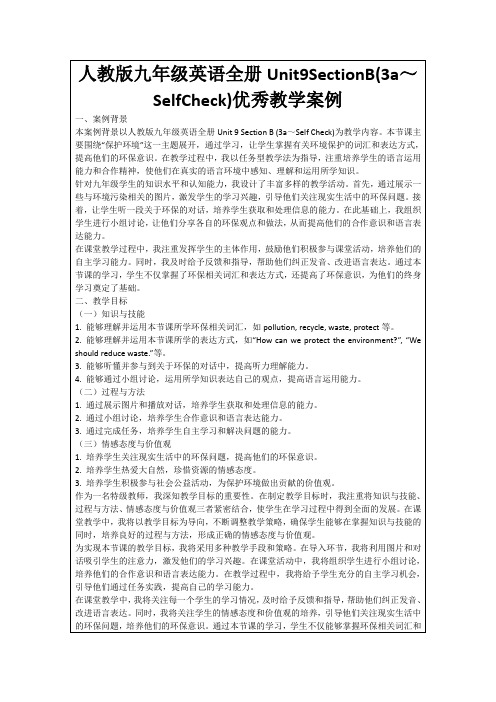
3.鼓励学生相互评价、相互帮助,培养他们批判性思维和自我改进的能力。
(四)反思与评价
1.引导学生对自己的学习过程进行反思,如“我在学习中遇到了什么问题?”,“我如何解决这些问题?”等,培养学生自主学习和解决问题的能力。
(二)问题导向
1.设计一些富有思考性的问题,引导学生主动探究、积极思考,如“为什么我们要保护环境?”,“我们应该如何减少污染?”等。
2.鼓励学生提出自己的问题,培养他们独立思考和解决问题的能力。
3.引导学生通过讨论、调查、研究等途径,寻找问题的答案,提高他们的信息处理能力。
(三)小组合作
1.组织学生进行小组讨论,让他们分享自己的观点和经验,培养他们的合作意识和团队精神。
作为一名特级教师,我深知教学案例亮点的重要性。在设计教学案例时,我注重突出五个亮点,使学生在学习过程中得到更好的教育和培养。这些亮点包括情境创设、问题导向、小组合作、反思与评价以及教学策略的灵活运用。通过这些亮点,我能够更好地关注学生的需求,培养他们的语言运用能力、独立思考能力和合作精神,并帮助他们形成正确的情感态度与价值观。
在情景创设环节,我将利用图片、视频等教学资源,为学生营造一个与环保相关的情境,激发他们的学习兴趣。我将设计一些模拟环保活动、角色扮演等教学活动,让学生在真实的语言环境中感知、理解和运用所学知识。通过这些情景创设,学生将能够更好地理解和运用所学知识,提高他们的语言运用能力。
在问题导向环节,我将设计一些富有思考性的问题,引导学生主动探究、积极思考。我将鼓励学生提出自己的问题,培养他们独立思考和解决问题的能力。通过引导学生进行讨论、调查、研究等途径,学生将能够寻找问题的答案,提高他们的信息处理能力。
人教版英语九年级全册Unit9 SectionB(2a-Self Check)名师教案

Unit9 SectionB〔2a-Self Check〕名师教案【教材版本与册数】新目标人教版九年级上册【单元名称】Unit 9 I like music that I can dance to.【课时】Section B 2a-Self Check〔第5课时〕【课型】Reading and Writing〔读写课〕教材分析【本单元话题】本单元以“音乐和电影〞为话题,以表达喜好为交际功能,重点在这些语境中学习和运用由that, who, which 引导的定语从句。
【本单元重点掌握目标】由that, who, which 引导的定语从句的用法。
2.能够用定语从句表达对音乐、电影等内容的喜好。
【教材内容拆分分析】2a-2e为Section B局部的阅读版块。
2a的读前活动从学生的已有认知出发,让学生尝试用自己的语言谈论中国的乐器及相关名曲,为阅读活动做准备。
2b要求学生阅读文章找出文中的关键信息。
2c让学生关注细节,通过表格填写,列出支撑作者观点的细节信息。
2d那么要求学生在理解的根底上运用所学目标构造将文章相关的一段细节描写补充完整。
2e是一个开放性的对话活动,要求学生在理解材料的根底上尝试运用所学语言实现对话输出。
3a-3b局部是写作训练版块。
3a是一个写作前的思考准备,呈现了与音乐或电影相关的问题,要求学生填写信息,整理写作要点。
3b布置写作任务并且提供了相关的短语和表达,以便学生完成写作任务。
6.学会应用本单元的知识谈论自己的喜好、感受和原因,并能在喜好上给别人提出建议。
,提高学生的写作能力。
情感态度价值观目标:继续学习有关个人喜好,使同学们共同提高审美水平,提高整体素质。
教学重难点教学重点:1.掌握本课时出现的生词及用法。
2.阅读短文,获得相关信息,提高学生们的综合阅读能力。
3.用that/who引导的定语从句描述个人喜好。
4.有关个人喜好的写作。
教学难点:1.阅读2b局部的短文并完成相关要求。
- 1、下载文档前请自行甄别文档内容的完整性,平台不提供额外的编辑、内容补充、找答案等附加服务。
- 2、"仅部分预览"的文档,不可在线预览部分如存在完整性等问题,可反馈申请退款(可完整预览的文档不适用该条件!)。
- 3、如文档侵犯您的权益,请联系客服反馈,我们会尽快为您处理(人工客服工作时间:9:00-18:30)。
Unit9 SectionB(3a-3b)优质课教案
Ⅰ.Studying Aims (学习目标):
1. Knowledge Objectives
Review SectionB 2b and learn key sentences. My favorite kind of music is (I)
like … because … It was … by …
When I listen to /watch it, I feel …
I think you should listen to / watch it to because …
2. Ability objective:
(1) Listen to the teacher’s story and fill the blanks.
(2) Ask and answer the questions about the story of the teacher.
(3) Read the model articles.
(4) Write articles about the students’ favorite music, movies etc.
3. Moral objectives:
Learn to love better lives and show the love of the Chinese traditional culture.
3. Key Points and Difficulty
Key Points:
Master the vocabularies, phrases and useful expressions about music.
Difficulty:
Use the useful expressions to describe their favorite.
II. Teaching Methods and Learning Strategies
(1) Communicative teaching method, task-based language teaching and situational teaching method.
(2) Working in groups and self-directed learning, evaluation learning
III. Teaching Aids
Multimedia show: recordings, pictures, video
IV. Teaching procedures
Step 1 Warming up and lead in the new lesson.
1.学生和教师跟随《英文版小苹果》合唱跳舞。
2.复习描述音乐的句型。
教师问学生随音乐跳舞的感受和对该音乐的感受。
T: How do you feel now? Do you like Little Apple? What’s your favorite music?
What kind of music do you like?
Step 2 Show the rule of evaluation
用参与宜昌音乐会需要票,引入介绍评价规则。
每回答老师一个问题就得到一张音乐图片。
然后将图片贴在表格中,完成表格英语字母构成的3个组成员每人会得到一张音乐票。
Step 3 Check listening
T: Let’s start our music journey. The first stop is Checking your listening. Listen to Miss Zeng’s story of music and fill in the blanks. Then check it in groups and show the answers. The teacher gives the pictures to the student whose answers are right. Step 4 Speaking practice
关于My Story about a concert of Erquan Yinyue .(复习2b课文)然后教师让学生分小组问关于故事的一些问题。
复习描述音乐的句型。
小组长扮演老师的角色。
然后选一组展示,教师在黑板上完成自己的作文。
Step 5 Learning
展示TFboys乐队,提升范文,让学生还原句子介绍喜欢的音乐。
My favorite kind of music is .
I like it because .
It was by TF boys.
When I listen to it, I feel . I think you should listen to it, too.
Because .
然后播放TFboys的歌曲,让学生听后,问是否喜欢。
加上文字的开头和结尾。
帮助学生分析文章结构。
文章有开头、主体和结尾三部分构成。
Step 6 Practice and reading
学生根据我讲的文章分析方法,分析教师关于音乐会的描述文章的结构。
标上序号。
再次巩固文章写法。
并朗读。
Step 7 Writing Practice
分7个小组分别谈论喜欢的书、动画、电影、电话、节日、发明。
然后独自写作文:我最喜爱的_______
Step 7 Show time。
